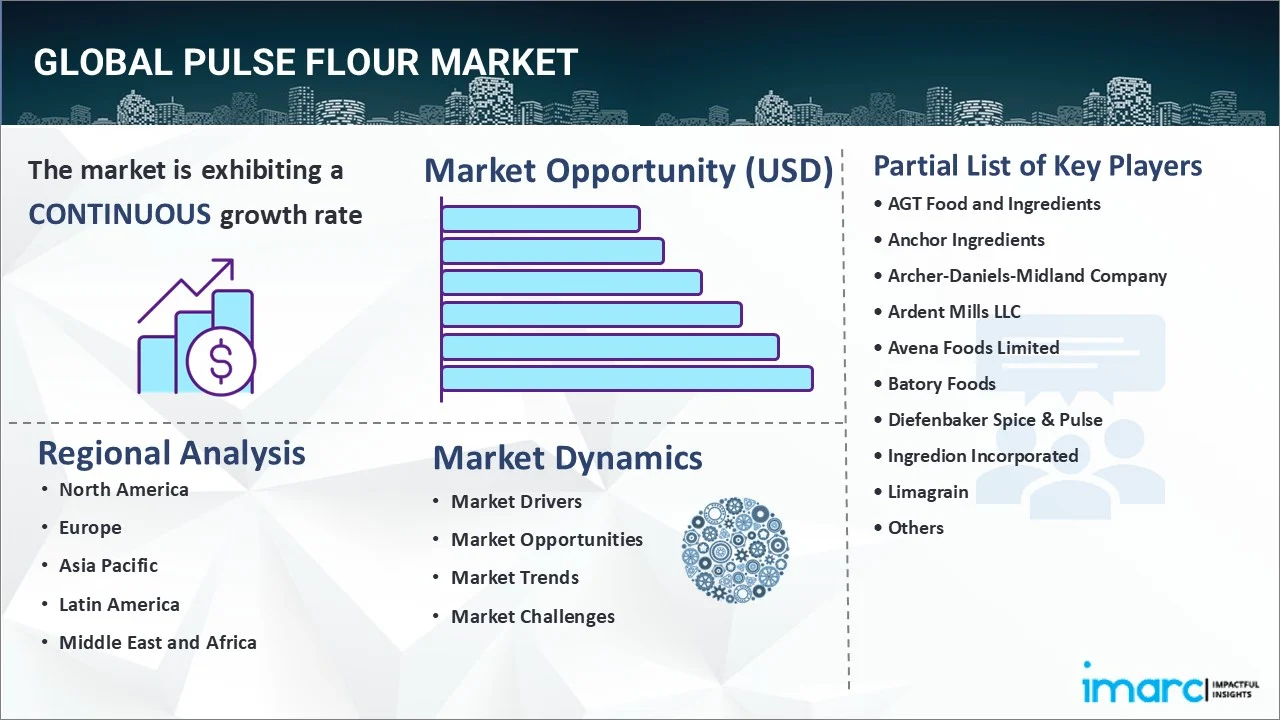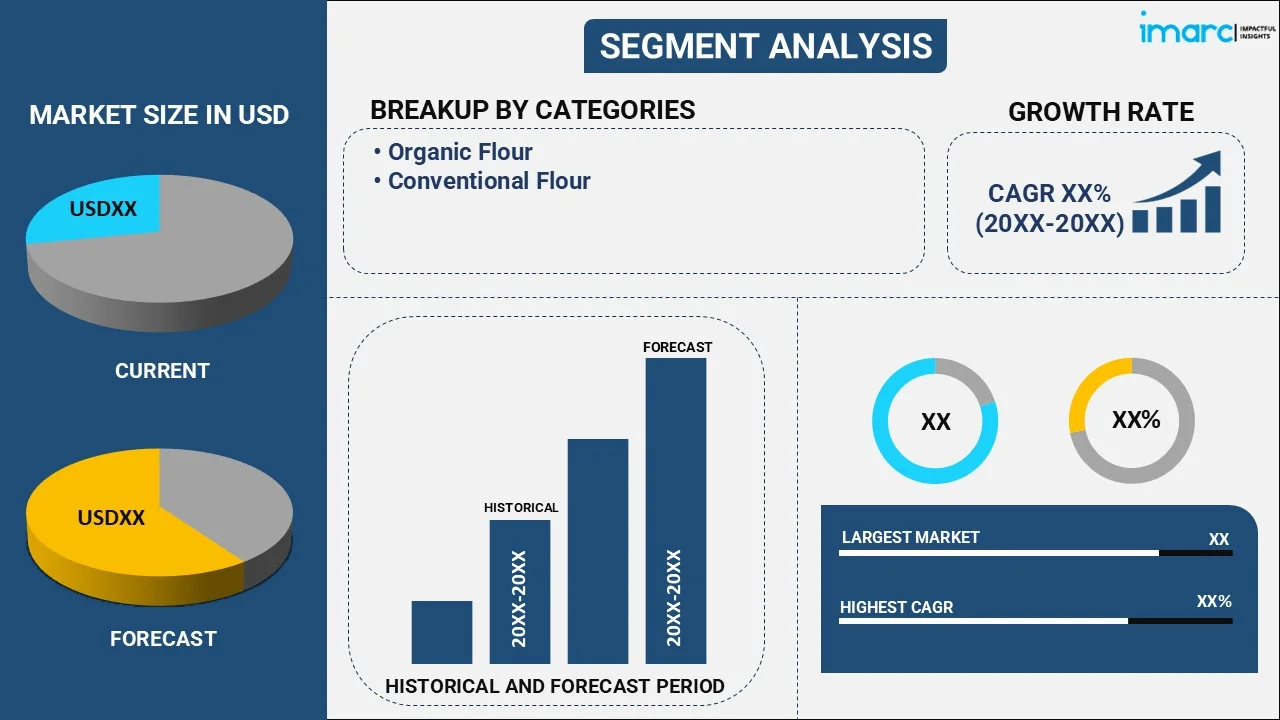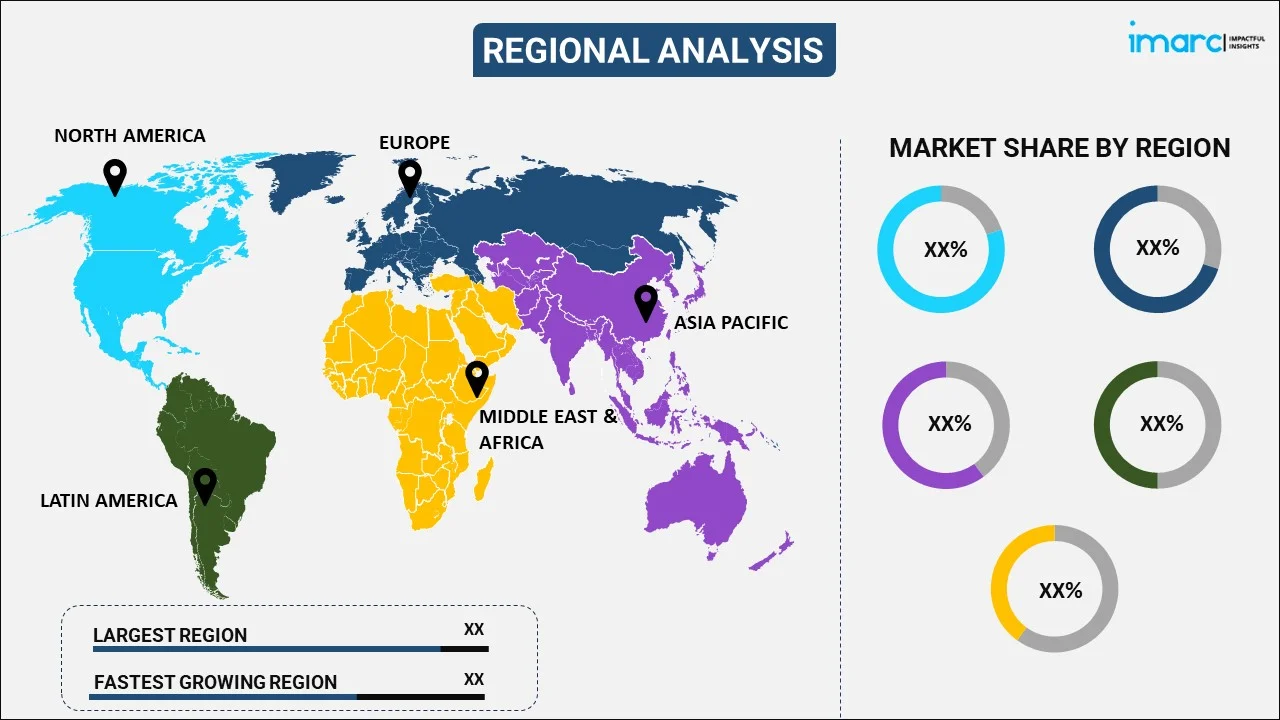
Pulse Flour Market Report by Category (Organic Flour, Conventional Flour), Type (Pea, Bean, Chickpea, Lentil, and Others), Application (Food, Feed, and Others), Distribution Channel (Supermarkets/Hypermarkets, Departmental Stores, Online Stores, Specialty Stores), and Region 2025-2033
Global Pulse Flour Market:
The global pulse flour market size reached USD 30.2 Billion in 2024. Looking forward, IMARC Group expects the market to reach USD 48.1 Billion by 2033, exhibiting a growth rate (CAGR) of 5.06% during 2025-2033. The rising health awareness, increasing shift towards plant-based and gluten free diets, continuous innovations in food products, and growing food allergies, are primarily propelling the market's growth.
|
Report Attribute
|
Key Statistics
|
|---|---|
|
Base Year
|
2024
|
|
Forecast Years
|
2025-2033
|
|
Historical Years
|
2019-2024
|
|
Market Size in 2024
|
USD 30.2 Billion |
|
Market Forecast in 2033
|
USD 48.1 Billion |
| Market Growth Rate 2025-2033 | 5.06% |
Pulse Flour Market Analysis:
- Major Market Drivers: The global pulse flour market is primarily driven by the rising awareness among consumers regarding the inclusion of healthy and nutritious food in their daily diet. Besides this, there is a shift in the preferences of the urban working population toward pulse flour due to the numerous health benefits associated with its consumption, which is further escalating the industry's demand.
- Key Market Trends: Rapid urbanization and increasing disposable incomes have further resulted in higher incorporation of pulse flour, which is propelling the growth of the market. Furthermore, governments worldwide are providing incentives for the increased cultivation of pulse crops, which has led to the easy availability of pulse flour across the globe, thereby anticipated to propel the market's growth.
- Competitive Landscape: Some of the prominent pulse flour market companies include AGT Food and Ingredients, Anchor Ingredients, Archer-Daniels-Midland Company, Ardent Mills LLC, Avena Foods Limited, Batory Foods, Diefenbaker Spice & Pulse, Ingredion Incorporated, Limagrain, and The Scoular Company, among many others.
- Geographical Trends: According to the pulse flour market dynamics, Asia Pacific exhibits a clear dominance in the market. The expanding population and rapid urbanization in Asia Pacific countries have led to an increased demand for convenient, nutritious food options, including pulse flour.
- Challenges and Opportunities: Fluctuating prices of pulses and the growing competition from alternative ingredients are hampering the market's growth. However, the growing consumer demand for healthier and nutrient-dense foods presents an opportunity for pulse flour, which is rich in protein, fiber, and essential nutrients.

Pulse Flour Market Trends:
Rising Demand for Gluten-Free Products
More people are becoming aware of gluten sensitivity and celiac disease, leading to a higher demand for gluten-free alternatives. For instance, according to an article published by the National Institutes of Health, nearly two million people in the United States have celiac disease and about 1% of people around the world have celiac disease. Pulse flour, which is naturally gluten-free, is an attractive option for those with these conditions. These factors are expected to propel the pulse flour market in the coming years.
Growing Adoption of a Plant-Based Diet
The growing adoption of plant-based diets is a major factor fueling the expansion of the pulse flour market. For instance, according to an article published by the National Library of Medicine, between 2014 and 2018, the number of Americans who adopt a vegan diet surged by 600%. Similarly, in 2023, according to Meticulous Research, 2.6 million are vegan, accounting for 3.2% of the total European population. As more people adopt plant-based or vegan diets for health, environmental, or ethical reasons, there is a heightened demand for plant-based ingredients. Pulse flour, made from legumes such as chickpeas, lentils, and peas, fits perfectly into these diets due to its high protein content and nutritional benefits. These factors further positively influence the pulse flour market forecast.
Increasing Product Innovations
The growing product innovations are escalating the market's demand. The food industry is continually developing new products that incorporate pulse flour, including baked goods, snacks, and pasta, which helps to drive market growth. For instance, in June 2020, AGT Foods in Minot launched a new pea-based pasta line called Veggipasta, which offers consumers a healthier option. Veggipasta is available at Marketplace Foods in Minot and Tellman’s Market in New Salem, thereby boosting the pulse flour market revenue.
Global Pulse Flour Industry Segmentation:
IMARC Group provides an analysis of the key trends in each segment of the global pulse flour market report, along with forecasts at the global, regional, and country levels from 2025-2033. Our report has categorized the market based on category, type, application, and distribution channel.
Breakup by Category:

- Organic Flour
- Conventional Flour
The report has provided a detailed breakup and analysis of the pulse flour market based on the category. This includes organic flour and conventional flour.
According to the pulse flour market outlook, pulse organic flour, made from pulses like chickpeas, lentils, or peas grown organically, typically appeals to those who prioritize environmental sustainability and natural farming practices. Moreover, organic flour generally commands a premium price due to the higher costs of organic farming and certification. However, conventional pulse flour is usually more affordable, which might attract cost-conscious consumers and those who use pulse flour in large quantities. Also, these are from pulses grown using standard agricultural practices, which may include the use of synthetic pesticides and fertilizers.
Breakup by Type:
- Pea
- Bean
- Chickpea
- Lentil
- Others
Chickpea currently holds the majority of the total market share
The report has provided a detailed breakup and analysis of the pulse flour market based on the type. This includes pea, bean, chickpea, lentil, and others. According to the report, chickpea currently holds the majority of the total market share.
According to the pulse flour market overview, chickpea flour is rich in protein, fiber, and essential vitamins and minerals, making it a popular choice among health-conscious consumers. It is naturally gluten-free, appealing to individuals with celiac disease or gluten sensitivity. Moreover, chickpea flour is used in a variety of cuisines, including Indian, Middle Eastern, and Mediterranean. It’s a key ingredient in dishes, like falafel, pakoras, and socca, which drives the demand in diverse culinary markets.
Breakup by Application:
- Food
- Bakery
- Extruded Food
- Meat Products
- Beverages
- Others
- Feed
- Others
Food exhibits a clear dominance in the market
A detailed breakup and analysis of the pulse flour market based on the application has also been provided in the report. This includes food (bakery, extruded food, meat products, beverages, and others), feed, and others. According to the report, food exhibits a clear dominance in the market.
Pulse flour can be used in various food applications, including baked goods (bread, muffins, cookies), snacks (chips, crackers), pasta, sauces, soups, and even meat substitutes. This versatility makes them highly desirable for food manufacturers. Moreover, it can improve the texture and nutritional profile of a wide array of food products. For example, chickpea flour can provide a unique flavor and density to baked items, while lentil flour can add a smooth texture to soups and sauces. Furthermore, with the increasing prevalence of gluten-free and plant-based diets, pulse flours offer a beneficial alternative to wheat and other grains, meeting the needs of those with gluten sensitivities or those following vegetarian or vegan lifestyles.
Breakup by Distribution Channel:
- Supermarkets/Hypermarkets
- Departmental Stores
- Online Stores
- Specialty Stores
A detailed breakup and analysis of the pulse flour market based on the distribution channel has also been provided in the report. This includes supermarkets/hypermarkets, departmental stores, online stores, and specialty stores.
Supermarkets and hypermarkets often offer a broad selection of pulse flours, including popular varieties like chickpea, lentil, and pea flour. This variety meets diverse consumer needs and preferences. Moreover, departmental stores may have a more limited selection compared to supermarkets but often focus on higher-end or specialty pulse flours. Besides this, online stores provide easy access to a wide range of pulse flours, including niche and hard-to-find varieties. This is especially appealing to consumers looking for specific products or those in remote areas. Furthermore, specialty stores, such as health food stores, organic markets, and international grocery stores, often offer a curated selection of pulse flours, catering to specific consumer segments.
Breakup by Region:

- North America
- United States
- Canada
- Asia-Pacific
- China
- Japan
- India
- South Korea
- Australia
- Indonesia
- Others
- Europe
- Germany
- France
- United Kingdom
- Italy
- Spain
- Russia
- Others
- Latin America
- Brazil
- Mexico
- Others
- Middle East and Africa
Asia-Pacific currently dominates the global market
The report has also provided a comprehensive analysis of all the major regional markets, which include North America (the United States and Canada); Europe (Germany, France, the United Kingdom, Italy, Spain, Russia, and others); Asia-Pacific (China, Japan, India, South Korea, Australia, Indonesia, and others); Latin America (Brazil, Mexico, and others); and the Middle East and Africa. According to the report, Asia-Pacific currently dominates the global market.
According to the pulse flour market statistics, rapid economic development and urbanization in the Asia-Pacific region are leading to changes in dietary habits. Urban consumers are more likely to adopt diverse and innovative food products, including those made from pulse flour. Moreover, there's an increasing awareness about health and nutrition among consumers. Pulse flour is rich in protein, fiber, and essential nutrients, which makes it an attractive option for health-conscious individuals. Besides this, with a rising prevalence of gluten intolerance and celiac disease, there is a growing demand for gluten-free alternatives. For instance, according to the Nizam's Institute of Medical Sciences (NIMS), more than 10% of people in India suffer from gluten intolerance. Pulse flour, being naturally gluten-free, is becoming a popular choice for gluten-free products.
Competitive Landscape:
The market research report has provided a comprehensive analysis of the competitive landscape. Detailed profiles of all major market companies have also been provided. Some of the key players in the market include:
- AGT Food and Ingredients
- Anchor Ingredients
- Archer-Daniels-Midland Company
- Ardent Mills LLC
- Avena Foods Limited
- Batory Foods
- Diefenbaker Spice & Pulse
- Ingredion Incorporated
- Limagrain
- The Scoular Company
(Please note that this is only a partial list of the key players, and the complete list is provided in the report.)
Pulse Flour Market Recent Developments:
- July 2024: Ingredion Incorporated launched Vitessence Pea 100 HD, a pea protein designed for cold-pressed bars to expand its line of North American-grown and produced protein fortification solutions in the United States and Canada.
- March 2024: Supplant Foods, a plant-based ingredients company, received a patent for a technique of producing high-performance chickpea flour for plant-based and gluten-free cuisine.
- September 2023: Banza, the manufacturer of chickpea-based comfort foods, launched Banza Protein Waffles in three flavors: Homestyle, Blueberry, and Chocolate Chip.
Pulse Flour Market Report Scope:
| Report Features | Details |
|---|---|
| Base Year of the Analysis | 2024 |
| Historical Period | 2019-2024 |
| Forecast Period | 2025-2033 |
| Units | Billion USD |
|
Scope of the Report |
Exploration of Historical Trends and Market Outlook, Industry Catalysts and Challenges, Segment-Wise Historical and Predictive Market Assessment:
|
| Categories Covered | Organic Flour, Conventional Flour |
| Types Covered | Pea, Bean, Chickpea, Lentil, Others |
| Applications Covered |
|
| Distribution Channels Covered | Supermarkets/Hypermarkets, Departmental Stores, Online Stores, Specialty Stores |
| Regions Covered | Asia Pacific, Europe, North America, Latin America, Middle East and Africa |
| Countries Covered | United States, Canada, Germany, France, United Kingdom, Italy, Spain, Russia, China, Japan, India, South Korea, Australia, Indonesia, Brazil, Mexico |
| Companies Covered | AGT Food and Ingredients, Anchor Ingredients, Archer-Daniels-Midland Company, Ardent Mills LLC, Avena Foods Limited, Batory Foods, Diefenbaker Spice & Pulse, Ingredion Incorporated, Limagrain, The Scoular Company, etc. |
| Customization Scope | 10% Free Customization |
| Post-Sale Analyst Support | 10-12 Weeks |
| Delivery Format | PDF and Excel through Email (We can also provide the editable version of the report in PPT/Word format on special request) |
Key Benefits for Stakeholders:
- IMARC's report offers a comprehensive quantitative analysis of various market segments, historical and current market trends, market forecasts, and dynamics of the pulse flour market from 2019-2033.
- The research study provides the latest information on the market drivers, challenges, and opportunities in the global pulse flour market.
- The study maps the leading, as well as the fastest-growing, regional markets. It further enables stakeholders to identify the key country-level markets within each region.
- Porter's five forces analysis assists stakeholders in assessing the impact of new entrants, competitive rivalry, supplier power, buyer power, and the threat of substitution. It helps stakeholders to analyze the level of competition within the pulse flour industry and its attractiveness.
- The competitive landscape allows stakeholders to understand their competitive environment and provides insight into the current positions of key players in the market.
Key Questions Answered in This Report
The global pulse flour market was valued at USD 30.2 Billion in 2024.
We expect the global pulse flour market to exhibit a CAGR of 5.06% during 2025-2033.
The rising demand for gluten-free food products, along with the growing adoption for pulse flour across the snacks industry to improve the characteristics of the dough and increase the protein content of the product, is primarily driving the global pulse flour market.
The sudden outbreak of the COVID-19 pandemic has led to the changing consumer inclination from conventional brick-and-mortar distribution channels towards online retail platforms for the purchase of pulse flour.
Based on the type, the global pulse flour market has been segmented into pea, bean, chickpea, lentil, and others. Among these, chickpea currently holds the majority of the total market share.
Based on the application, the global pulse flour market can be divided into food, feed, and others. Currently, food exhibits a clear dominance in the market.
On a regional level, the market has been classified into North America, Asia-Pacific, Europe, Latin America, and Middle East and Africa, where Asia-Pacific currently dominates the global market.
Some of the major players in the global pulse flour market include AGT Food and Ingredients, Anchor Ingredients, Archer-Daniels-Midland Company, Ardent Mills LLC, Avena Foods Limited, Batory Foods, Diefenbaker Spice & Pulse, Ingredion Incorporated, Limagrain, and The Scoular Company.
Need more help?
- Speak to our experienced analysts for insights on the current market scenarios.
- Include additional segments and countries to customize the report as per your requirement.
- Gain an unparalleled competitive advantage in your domain by understanding how to utilize the report and positively impacting your operations and revenue.
- For further assistance, please connect with our analysts.
 Inquire Before Buying
Inquire Before Buying
 Speak to an Analyst
Speak to an Analyst
 Request Brochure
Request Brochure
 Request Customization
Request Customization




.webp)




.webp)












